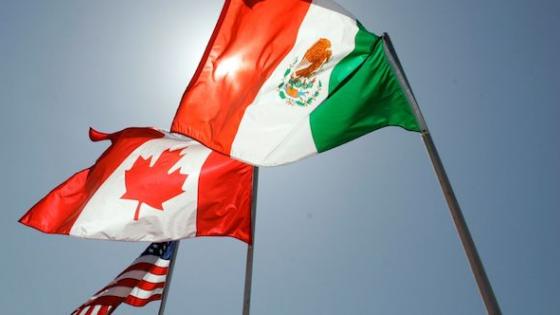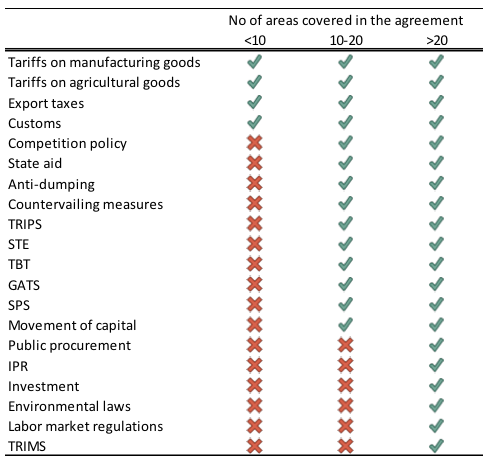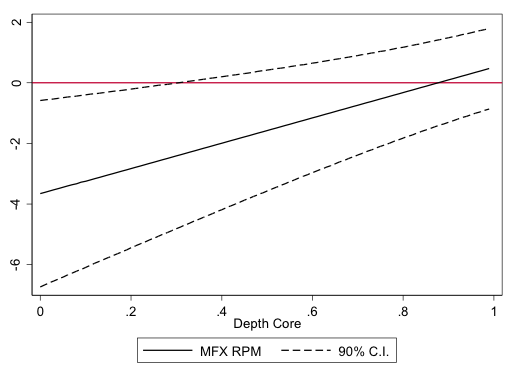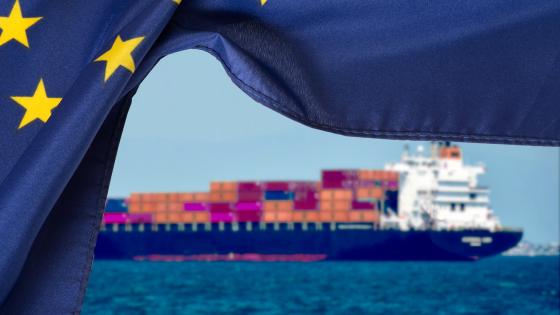Brexit and the renegotiation of NAFTA have renewed the interest of policymakers in how trade agreements affect trade and the consequences of undoing them (Blanchard 2017, Dhingra et al. 2016, Mulabdic et al. 2017). In a recent paper, we use new information on the content of preferential trade agreements (PTAs) to examine the trade effects of deep integration (Mattoo et al. 2017). Our findings may inform the current debate on the consequences of disintegration.
The evolution of preferential trade agreements
The number of trade agreements has grown dramatically since the early 1990s. Considering only the PTAs still in force in 2015, the number of preferential arrangements increased from 20 in 1990 to 279 at the end of 2015. The content of PTAs too has changed. Newer agreements are deeper in the sense that the set of policy areas covered has expanded. Older PTAs focused on fewer than ten policy areas, which were mostly commitments on tariffs on industrial and agricultural goods and other border measures such as export taxes. Newer agreements extended their reach, first to areas such as trade remedies (i.e. countervailing measures, antidumping duties) and subsidies, and then to a broader set of behind the border measures relating to services trade, investment, intellectual property rights and domestic regulation (Table 1).
Table 1 Policy areas typically included in agreements of varying depth
Note: a provision is shown as included in a particular category if it is covered by more than 60% of agreements in that category
Deep agreements lead to greater trade creation…
To assess the impact of deep agreements on members and non-members’ trade, we augment a standard gravity model to include a variable that captures the depth of agreements between PTA members, and another that captures the depth of the agreements of a trading partner with other countries. Using information from a database on the content of PTAs (Hofmann et al. 2017), we construct different measures of depth based on the policy areas regulated by the agreements and their legal enforceability. Our sample covers 96 countries, including all major economies, for the period 2002-2014.
We find that the formation of deep agreements has a significant positive impact on the trade flows among members. In particular, we find that even after controlling for tariffs and for a PTA dummy, a deep agreement increases trade between country pairs by 44%. The estimates suggest that deep agreements induce more trade creation than shallow PTAs. When we look at the dynamic effects of deep agreements, we find that future levels of PTA depth are statistically uncorrelated with current levels of trade flows, suggesting that depth of agreements is not determined by the closeness of current trade relations. On average, it takes two years for deep agreements to increase trade flows, consistently with the evidence that reforms of behind the border measures take time to implement (Figure 1).
Figure 1 Dynamic effects of depth
Note: Depth is defined as the count of legally enforceable provisions. Results are based on a Poisson Pseudo Maximum-Likelihood (PPML) estimator of a gravity model that includes lags and leads of the depth variable, in addition to bilateral fixed effects and country-time fixed effects. 90% confidence intervals (C.I.) are constructed using robust standard errors, clustered by country-pair.
…and ‘negative’ trade diversion
Despite this strong evidence of trade creation, the deepening of trade agreements does not appear to happen at the expenses of trade with non-members. Specifically, a standard deviation increase in the average depth of the partner’s trade agreements with other countries increases bilateral trade by around 19%. As hypothesised in Baldwin (2014), we find that this ‘negative’ trade diversion of deep agreements is driven by the inclusion of non-discriminatory provisions, such as those that regulate competition policy, subsidies and standards, which enhance trade also vis-à-vis outsiders, creating a positive spillover effect. Tariff preferences (and other preferential provisions) are still found to divert trade with non-members, but deep agreements tend to moderate the trade diverting effect of tariff preferences. The negative impact of relative tariff preferences on trade is significantly dampened by deeper agreements (Figure 2).
Figure 2 Marginal effect of relative tariff preferences (MFX RPM)
Note: Depth Core is defined as the count of core legally enforceable provisions. Results are based on a Poisson Pseudo Maximum-Likelihood (PPML) estimator of a gravity model that includes an interaction term between the relative preference margin and importer’s maximum value of depth core. 90% confidence intervals (C.I.) are constructed using robust standard errors, clustered by country-pair.
Some examples may help put these findings in perspective. We focus on three trade agreements with increasing levels of depth – as measured by the number of policy areas covered by the treaty – namely, Peru-Chile, Korea-US, and the EU. Based on our preferred specifications, a shallow agreement such as Peru-Chile increased bilateral trade by an estimated 10%, but had a negligible impact on non-members. Korea-US, a medium-depth PTA, increased trade by 14% and also raised exports from outsiders by 4%. Finally, our estimates suggest that the deepest agreement in our sample, the EU, increased trade flows among members by 44%, while exports from non-EU countries would be around 30% lower in the absence of the agreement.
The enduring need for deep regional integration
Trade agreements such as NAFTA and the EU have complemented multilateral integration and helped support trade growth. These agreements have tended to cover areas not fully dealt with at the multilateral level, and the provisions in several of these areas are inherently non-discriminatory, boosting also trade with third countries. Our research indicates that reversing these agreements would hurt not just participating countries but also their other trading partners.
Authors’ note: The views expressed in this article are those of the authors and they do not necessarily represent the views of the World Bank Group.
References
Baldwin, R (2014), “Multilateralising 21st Century Regionalism”. Paper prepared for the OECD conference “Global Forum on Trade Reconciling Regionalism and Multilateralism in a Post-Bali World”.
Blanchard, E (2017), “Renegotiating NAFTA: The role of global supply chains”, VoxEU.org, 30 July.
Dhingra, S, G Ottaviano, T Sampson and J Van Reenen (2016), “The Consequences of Brexit for UK Trade and Living Standards”, VoxEU, 4 April.
Hofmann C, A Osnago, and M Ruta (2017), “Horizontal Depth: A New Database on the Content of Preferential Trade Agreements”, Policy Research Working Paper Series 7981, World Bank, Washington, DC.
Mattoo, A, A Mulabdic, and M Ruta (2017), “Trade creation and trade diversion in deep agreements”, Policy Research Working Paper Series 8206, World Bank, Washington, DC.
Mulabdic, A, A Osnago, and M Ruta. (2017), “Trading off a ’soft’ and ‘hard’ Brexit”, VoxEU.org, 23 January.








